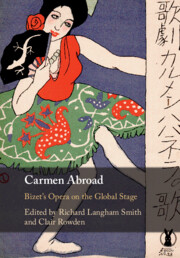Book contents
- Carmen Abroad
- Carmen Abroad
- Copyright page
- Contents
- Figures
- Tables
- Preface
- Acknowledgements
- Notes on Contributors
- Part I Establishment in Paris and the Repertoire
- Part II Across Frontiers
- 7 A New Performance for the New World: Carmen in America
- 8 The Unstoppable March of Time: Carmen, and New Orleans in Transition
- 9 The Return of the Habanera: Carmen’s Early Reception in Latin America
- 10 From Spain to Lusophone Lands: Carmen in Portugal and Brazil
- 11 Carmen in the Antipodes
- 12 Carmen, as Seen and Heard in Victorian Britain
- 13 Celtic Carmens: Rebellion and Redemption
- 14 Carmen for the Czechs and Germans, 1880 to 1945
- 15 Carmen in Poland prior to 1918
- 16 A Woman or a Demon: Carmen in the Late Nineteenth-Century Nordic Countries
- Part III Localising Carmen
- Selected Bibliography
- Index
- References
13 - Celtic Carmens: Rebellion and Redemption
from Part II - Across Frontiers
Published online by Cambridge University Press: 18 September 2020
- Carmen Abroad
- Carmen Abroad
- Copyright page
- Contents
- Figures
- Tables
- Preface
- Acknowledgements
- Notes on Contributors
- Part I Establishment in Paris and the Repertoire
- Part II Across Frontiers
- 7 A New Performance for the New World: Carmen in America
- 8 The Unstoppable March of Time: Carmen, and New Orleans in Transition
- 9 The Return of the Habanera: Carmen’s Early Reception in Latin America
- 10 From Spain to Lusophone Lands: Carmen in Portugal and Brazil
- 11 Carmen in the Antipodes
- 12 Carmen, as Seen and Heard in Victorian Britain
- 13 Celtic Carmens: Rebellion and Redemption
- 14 Carmen for the Czechs and Germans, 1880 to 1945
- 15 Carmen in Poland prior to 1918
- 16 A Woman or a Demon: Carmen in the Late Nineteenth-Century Nordic Countries
- Part III Localising Carmen
- Selected Bibliography
- Index
- References
Summary
Carmen was produced in Ireland and Brittany in 1878 when both populations were exploring questions of identity. In Ireland, the tension between the local inhabitants and their colonial masters was giving rise to Celtic nationalism. In Brittany, while regional identity was important, so too was the connection with wider French culture.
Breton productions relied largely on local forces, (the notable exception being Célestine Galli-Marié, the original Parisian Carmen), with careful preparation, rehearsal and advanced publicity. Brittany was fortunate in having publicly subsidised theatres and municipal support for singers, orchestras and choruses which facilitated productions. In contrast, Irish theatres were privately owned, depending largely on touring companies, usually from Britain. The impresario Mapleson, manager of the Italian Opera Company, had arranged to take his production with Minnie Hauk as Carmen from London to New York, but finding that theatres were available in both Dublin and Cork, seized the opportunity to present a short season in Ireland before embarking for America.
The critical reception was mixed, with good and bad reviews after every performance. Whereas the Irish Carmen was seen to reflect the rebellious spirit of the age, Carmen in Brittany followed the redemptive route of the religious pardon of local ritual.
Keywords
- Type
- Chapter
- Information
- Carmen AbroadBizet's Opera on the Global Stage, pp. 200 - 214Publisher: Cambridge University PressPrint publication year: 2020



